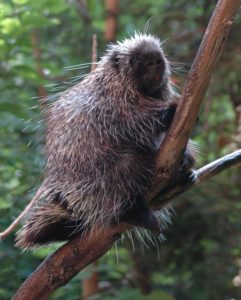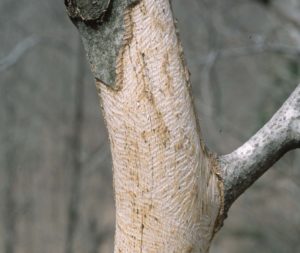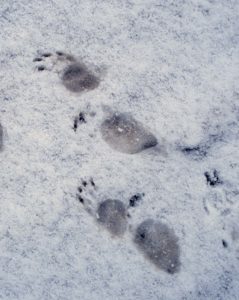The North American Porcupine
by Linda Spielman
Consider the porcupine: a slow, ungainly creature with short
legs and a chunky body and, it would seem, poor prospects for
survival. But the porcupine is clothed in a defensive array that
stops all but the most determined predators. Interspersed
throughout its thick fur are quills up to 4 inches long. Their
sharp tips bear backward-pointing barbs that cause the spines
to work their way inward once they pierce the skin of an
attacker. As the quills move deeper into an animal’s flesh they
may pierce vital organs causing fatal injury. Even if the only
result of an encounter with a porky is a mouth or paw full of
quills, the ability of the predator to hunt and eat may be
seriously compromised. Contrary to common belief porcupines can’t throw their quills, but they do have adaptations that help
them to use their quills effectively. The quills can be raised and lowered at will, and special muscles under the skin release the projectiles when they contact another animal. Quills are borne on the tail as well as the body, and when threatened a porky aims its rear end toward the attacker and makes lightning-fast strikes with its tail.
Porcupines are among North America’s largest rodents (only the beaver is larger), and like many rodents their diet consists almost entirely of plant material. In winter they subsist on the bark of deciduous and coniferous trees and the twigs and leaves of conifers. They are efficient bark chewers, first using their sharp incisors to remove and discard the dead outer layers and then neatly scraping off the living cambium cells that lie underneath. The photo shows the strikingly even patterns of tooth marks characteristic of porcupine chews. If the fall acorn crop has been abundant porkies eat any
larger), and like many rodents their diet consists almost entirely of plant material. In winter they subsist on the bark of deciduous and coniferous trees and the twigs and leaves of conifers. They are efficient bark chewers, first using their sharp incisors to remove and discard the dead outer layers and then neatly scraping off the living cambium cells that lie underneath. The photo shows the strikingly even patterns of tooth marks characteristic of porcupine chews. If the fall acorn crop has been abundant porkies eat any
surplus that lasts into winter, and they occasionally add protein to their
intake by chewing on animal carcasses. Even with those additions the poor quality of the winter diet leads to a gradual decline in the animals’ health and vitality.
In spring swelling tree buds and developing flowers offer a nutrition booster, and things really improve with summer’s bounty of tree leaves, herbaceous stems and leaves, truffles, aquatic plants, seeds, fruits, acorns, and nuts. Insufficient sodium in the diet may cause porkies to chew on tires, insulated wiring, plywood, tool handles, and other strange objects.
At Hammond Hill I’ve found both tracks and scat of porcupines.
Porcupine tracks are unmistakable—both the larger rear prints and the
smaller front prints have broad oval soles and prominent claw marks
which lie well ahead of the front edges of the soles. The photo shows
(from bottom to top) the left rear, left front, right rear, and right front
tracks.
Because porcupines produce a steady output of fecal pellets as they go through their daily rounds, their scat is also a good indicator of where they have been. I’ve found the slightly curved tubular pellets, about ½ inch in
diameter and an inch or more long (see photo), in feeding areas and along trails. Compared to deer scat, porcupine scat is often kidney-shaped rather than strictly cylindrical and lacks the dimpled end.
Except at a den (more on that below), it tends to be scattered widely throughout feeding areas, along travel routes, or under trees rather than in piles as deer scat is. Chews are another indicator of the presence of porcupines. Sometimes the animals feed near the ground where the patterns of tooth marks (smaller than those made by beavers and often far from any body of water) can be seen close-up. If porcupines feed higher in the tree canopy we may not be able to see the individual tooth marks, but the irregular patches of exposed wood
stand out against the darker bark. In our region the only other animals that create similar debarked patches in living bark high in trees are gray squirrels, but bark feeding by squirrels is uncommon. And if a porcupine has chewed
long enough to create visible debarked patches, its scat—much larger than squirrel scat—will most likely be found below the feeding tree.
Dens, usually found in rock crevices or hollow trees, provide porkies with shelter and safety. A good den allows the animal to keep its head—its most vulnerable part—safely wedged in a rock or wood cleft while its tail is aimed at an attacker. Porcupines are not fastidious creatures, and they keep producing a steady stream of fecal pellets even when they are in the den. Regularly occupied dens are marked by conspicuous cascades of scat (see photo).
provide porkies with shelter and safety. A good den allows the animal to keep its head—its most vulnerable part—safely wedged in a rock or wood cleft while its tail is aimed at an attacker. Porcupines are not fastidious creatures, and they keep producing a steady stream of fecal pellets even when they are in the den. Regularly occupied dens are marked by conspicuous cascades of scat (see photo).
I haven’t yet found a den at Hammond Hill, but I’m convinced there must be at least one in the area. The animals’ movements are limited, especially in winter, and the distance between dens and feeding areas is usually not great. I’ll stay alert for tracks and sign, and I’ll continue to roam the hills in search of a waterfall of porcupine scat.
